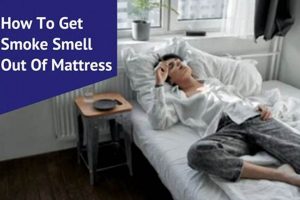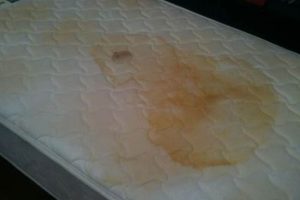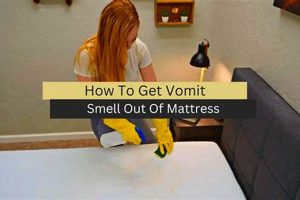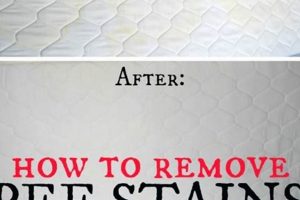The removal of desiccated bloodstains from a mattress presents a common domestic challenge. Successful remediation necessitates prompt action and the application of appropriate cleaning methodologies to prevent permanent staining and maintain the hygiene of the sleeping surface.
Addressing bloodstains on a mattress is important for several reasons. Firstly, it prevents the stain from setting permanently, which can be aesthetically displeasing and potentially harbor bacteria. Secondly, effective stain removal contributes to the longevity of the mattress, preserving its value and usability. Historically, various techniques have been employed, ranging from basic water and soap solutions to more specialized enzymatic cleaners. The selection of a suitable method depends on the stain’s age, severity, and the mattress material.
The following sections will detail effective techniques for eliminating dried bloodstains from mattresses, outlining the necessary materials and step-by-step procedures for optimal results.
Strategies for Mattress Bloodstain Removal
The following details established methods for addressing dried bloodstains on mattresses. Diligence and careful execution of these strategies enhance the likelihood of complete stain removal and minimize potential damage to the mattress.
Tip 1: Cold Water Application: Initially, employ a clean cloth dampened with cold water to blot the affected area. Avoid rubbing, as this can spread the stain and embed it further into the mattress fibers. The cold temperature helps prevent the blood from setting.
Tip 2: Enzyme Cleaner Utilization: Enzyme-based cleaners are specifically formulated to break down organic matter, including blood. Apply the cleaner according to the manufacturer’s instructions, ensuring proper ventilation of the room during and after application. Allow sufficient dwell time for the enzymes to effectively break down the stain.
Tip 3: Baking Soda Paste Preparation: Create a paste using baking soda and cold water. Apply the paste to the stain and allow it to dry completely. The baking soda absorbs the stain and any lingering odors. Vacuum the dried paste thoroughly.
Tip 4: Hydrogen Peroxide Precautions: Hydrogen peroxide (3% solution) can be effective but should be used cautiously, especially on colored mattresses, as it may cause discoloration. Test the solution on an inconspicuous area first to ensure colorfastness. Blot gently with a cloth dampened with hydrogen peroxide, then blot with a clean, damp cloth to remove any residue.
Tip 5: Salt Solution Application: For fresh stains, a solution of cold water and salt can be effective. The salt helps to draw the blood out of the mattress fibers. Apply the solution, let it sit for a period, and then blot with a clean cloth.
Tip 6: Vinegar Solution Implementation: White vinegar is a mild acid that can help dissolve bloodstains. Mix white vinegar with equal parts of cold water and spray the solution onto the stain. Allow it to sit for 30 minutes, and then blot with a clean cloth.
Tip 7: Consider Professional Cleaning: If the stain persists or the mattress is particularly delicate, engaging a professional mattress cleaning service may be necessary. Professionals have access to specialized equipment and cleaning agents that can safely and effectively remove stubborn stains.
Effective stain removal from a mattress requires prompt action and the utilization of appropriate techniques. The selection of a specific method should be based on the stain’s age, severity, and the mattress composition. Prior testing of cleaning solutions in an inconspicuous area is recommended to mitigate the risk of damage.
The subsequent sections will explore preventative measures to minimize the occurrence of mattress bloodstains and further resources for mattress care and maintenance.
1. Cold Water Initially
The immediate application of cold water to a bloodstain on a mattress is a crucial first step in stain removal. This action is predicated on the understanding of blood’s composition and how it interacts with fabric fibers. Failure to address the stain promptly and with the correct temperature of water can lead to permanent staining and necessitate more aggressive, potentially damaging cleaning methods.
- Protein Coagulation
Blood contains proteins that coagulate when exposed to heat. Hot water accelerates this process, causing the proteins to bind more tightly to the mattress fibers, rendering the stain more difficult to remove. Cold water, conversely, minimizes coagulation, allowing the blood to remain more soluble and easier to lift from the fabric.
- Preventing Stain Penetration
Prompt application of cold water helps to prevent the blood from penetrating deeper into the mattress layers. Mattresses are often constructed with multiple layers of fabric and padding, and blood that seeps into these layers becomes significantly more challenging to extract. By addressing the stain immediately, the blood remains closer to the surface, facilitating removal.
- Dilution and Suspension
Cold water acts as a diluent, reducing the concentration of the bloodstain. It also helps to suspend the blood particles, preventing them from adhering strongly to the fibers. This suspension allows subsequent cleaning agents to be more effective in lifting the stain without damaging the mattress material.
- Maintaining Mattress Integrity
Aggressive cleaning methods, such as scrubbing with harsh chemicals or using excessive heat, can compromise the integrity of the mattress. The gentle action of cold water, followed by appropriate cleaning solutions, minimizes the risk of damaging the fabric, padding, or internal components of the mattress.
In essence, the initial application of cold water is a foundational step in addressing bloodstains on mattresses. It mitigates protein coagulation, limits stain penetration, aids in dilution and suspension, and safeguards mattress integrity, thereby increasing the effectiveness of subsequent stain removal techniques.
2. Enzyme Cleaner Application
Enzyme cleaner application represents a targeted approach for removing dried blood from mattresses, leveraging the biochemical properties of enzymes to break down complex organic molecules. This method offers a potentially less abrasive alternative to harsh chemical treatments, minimizing the risk of damage to delicate mattress materials.
- Mechanism of Action
Enzyme cleaners contain specific enzymes, such as proteases, which catalyze the hydrolysis of proteins. Dried blood consists largely of proteins, and the enzymatic action breaks these proteins down into smaller, more water-soluble fragments. This process weakens the bond between the bloodstain and the mattress fibers, facilitating easier removal during subsequent cleaning steps.
- Specificity and Safety
The effectiveness of enzyme cleaners hinges on the specificity of the enzymes used. Ideally, the enzymes should target the proteins present in blood while minimizing activity against the materials comprising the mattress. Selecting a cleaner specifically formulated for stain removal from fabric is crucial to ensure safety and prevent unintended damage or discoloration.
- Application Protocol
Effective enzyme cleaner application involves saturating the affected area with the cleaner and allowing sufficient dwell time for the enzymatic reaction to occur. Following the manufacturer’s instructions regarding application technique and dwell time is essential. After the designated dwell time, the treated area should be blotted with a clean cloth to remove the dissolved blood and cleaner residue.
- Post-Treatment Considerations
Following enzyme cleaner application, thorough drying of the treated area is critical to prevent mold or mildew growth within the mattress. Adequate ventilation and the use of fans or dehumidifiers can expedite the drying process. In some cases, a second application may be necessary for stubborn stains. If the stain persists after multiple treatments, professional cleaning services should be considered.
The strategic utilization of enzyme cleaners offers a targeted and potentially less damaging approach to addressing dried bloodstains on mattresses. Understanding the mechanism of action, selecting appropriate products, adhering to proper application protocols, and addressing post-treatment considerations are all integral to achieving successful stain removal and maintaining the integrity of the mattress.
3. Baking Soda Absorption
Baking soda, or sodium bicarbonate, serves as a valuable absorbent agent in the context of mattress stain removal. Its efficacy stems from its chemical properties and its ability to draw moisture and odor from porous materials. In addressing dried bloodstains, baking soda offers a non-aggressive method for lifting residual discoloration and mitigating associated odors.
- Mechanism of Absorption
Baking soda’s porous structure enables it to absorb liquids and odors through a process of adsorption. When applied to a dried bloodstain, it draws moisture from the surrounding fibers, which can rehydrate and lift the stain. The increased surface area of baking soda allows it to bind with odor molecules, neutralizing them effectively.
- Application and Dwell Time
The process involves liberally applying baking soda to the affected area, ensuring complete coverage of the stain. A dwell time of several hours, or even overnight, is recommended to allow for optimal absorption. This extended contact period maximizes the drawing out of moisture and odor molecules from the mattress fibers.
- Vacuuming and Residue Removal
Following the dwell time, thorough vacuuming is essential to remove the baking soda and any absorbed residue. A vacuum with a hose attachment and brush head is most effective for extracting the baking soda from the mattress fibers. Multiple passes may be necessary to ensure complete removal.
- Odor Neutralization
Beyond stain removal, baking soda’s odor-neutralizing properties are particularly beneficial in addressing bloodstains, which can leave a lingering metallic scent. The baking soda binds with these odor molecules, effectively eliminating them and leaving the mattress smelling fresher.
The application of baking soda as an absorbent agent represents a safe and effective method for addressing the residual effects of dried bloodstains on mattresses. Its absorptive and odor-neutralizing properties contribute to the overall cleanliness and hygiene of the sleeping surface, complementing other stain removal techniques.
4. Hydrogen Peroxide Caution
The application of hydrogen peroxide in the context of bloodstain removal from mattresses requires careful consideration. While its oxidizing properties can effectively lighten or eliminate stains, improper use poses a risk of irreversible damage to mattress materials. Understanding the concentration, application method, and potential interactions with mattress fibers is crucial to mitigating these risks.
Hydrogen peroxide acts as a bleaching agent due to its ability to release oxygen, which breaks down the colored compounds in the bloodstain. However, this bleaching action is not selective and can also affect the dyes or pigments in the mattress fabric, leading to discoloration or fading. For instance, using a concentration higher than 3% can cause significant lightening, particularly on colored mattresses, rendering the treated area noticeably different from the surrounding fabric. Moreover, repeated or excessive applications can weaken the fibers, reducing the mattress’s structural integrity and lifespan. A real-world example involves mattresses with printed patterns; direct application of hydrogen peroxide can obliterate these patterns, leading to aesthetic damage. The practical significance of understanding these cautions lies in preserving the mattress’s appearance and prolonging its usability. Prior testing on an inconspicuous area is essential to assess the fabric’s reaction and prevent widespread damage.
In summary, while hydrogen peroxide can be a useful tool in bloodstain removal, its application must be approached with caution. Understanding the potential for discoloration, fiber damage, and the need for prior testing is essential. Employing alternative methods or seeking professional assistance when dealing with delicate or valuable mattresses is advisable. The key to effective and safe stain removal lies in a balanced approach, weighing the benefits against the potential risks and prioritizing the mattress’s long-term integrity.
5. Professional Intervention
The removal of dried blood from mattresses occasionally necessitates professional intervention due to the stain’s severity, age, or the delicate nature of the mattress materials. When domestic stain removal attempts prove unsuccessful, or the potential for damage during DIY cleaning is deemed too high, engaging a professional mattress cleaning service becomes a prudent course of action. The professional approach typically involves specialized equipment and cleaning agents unavailable to the general public, increasing the likelihood of complete stain removal without compromising the mattress’s integrity.
Professional cleaning services often employ extraction methods that thoroughly remove both the stain and any residual cleaning solutions, minimizing the risk of mold or mildew growth within the mattress. Furthermore, trained technicians possess the expertise to identify the mattress’s composition and select the most appropriate cleaning techniques accordingly. For instance, a memory foam mattress requires different handling than an innerspring mattress, and professionals are equipped to navigate these nuances. Real-world examples include cases where homeowners have inadvertently damaged mattresses by using harsh chemicals or excessive moisture, leading to costly repairs or replacements. In such situations, professional intervention could have prevented the damage and achieved a more satisfactory outcome.
In conclusion, professional intervention plays a crucial role in addressing particularly challenging cases of dried bloodstains on mattresses. While DIY methods may suffice for minor or recent stains, the complexity and potential risks associated with stubborn stains often warrant the expertise and specialized resources of a professional cleaning service. The practical significance of understanding this lies in making informed decisions regarding mattress care and maintenance, ultimately preserving the mattress’s longevity and hygiene.
Frequently Asked Questions
The following addresses common inquiries regarding the effective removal of dried bloodstains from mattresses. The information provided aims to offer practical guidance and informed decision-making in this context.
Question 1: What is the most critical factor in successfully removing dried blood from a mattress?
Prompt action is paramount. The longer the blood remains on the mattress, the more deeply it penetrates the fibers, increasing the difficulty of complete removal.
Question 2: Is hot water an effective cleaning agent for bloodstains?
Hot water should be avoided. It causes the proteins in the blood to coagulate, setting the stain and making it more resistant to removal. Cold water is generally recommended.
Question 3: Are commercial stain removers always the best option?
Commercial stain removers can be effective, but caution is advised. Some may contain harsh chemicals that damage the mattress fabric or leave behind harmful residues. Always test the product on an inconspicuous area first.
Question 4: What alternative cleaning agents can be used if commercial stain removers are not available?
Several alternatives exist, including a solution of cold water and salt, a paste of baking soda and water, or a diluted hydrogen peroxide solution (3%). Always exercise caution and test on an inconspicuous area first.
Question 5: How can the development of mold or mildew within the mattress be prevented after cleaning?
Thorough drying is crucial. Utilize fans, dehumidifiers, or direct sunlight (if appropriate for the mattress material) to ensure the mattress is completely dry. Baking soda can also be applied to absorb any residual moisture.
Question 6: When is professional cleaning recommended?
Professional cleaning is recommended for severe or persistent stains, delicate mattress materials, or when DIY methods have proven ineffective. Professionals possess specialized equipment and expertise to safely and effectively remove stubborn stains.
In summary, successful removal of dried blood from a mattress necessitates prompt action, appropriate cleaning agents, and thorough drying. When in doubt, seeking professional assistance is always a prudent choice.
The subsequent section will delve into preventative measures to minimize the occurrence of bloodstains on mattresses and prolong the life of the mattress.
Conclusion
The preceding discussion has elucidated effective strategies for addressing the challenge of how to get dried blood out of mattress materials. Key methodologies include prompt cold-water application, the targeted use of enzyme cleaners, the absorbent properties of baking soda, cautious hydrogen peroxide implementation, and, when necessary, professional intervention. Adherence to these outlined procedures maximizes the probability of successful stain removal, thereby preserving the mattress’s condition and hygiene.
The commitment to maintaining a clean and sanitary sleeping environment is essential. Implementing the described techniques represents a proactive investment in the longevity and healthfulness of the mattress, ensuring sustained comfort and contributing to overall well-being. Vigilance and informed action remain paramount in upholding the integrity of this vital household asset.







